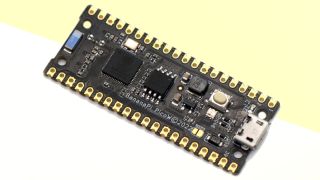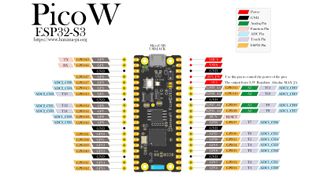Banana Pi PicoW Takes On Raspberry Pi Pico
Choose your fruit, microcontroller fans

The Raspberry Pi Pico form factor is one that’s just begging to be copied, but Banana Pi has gone one better and borrowed the name, too. The BPI-PicoW-S3, brought to our attention by CNX Software, is a new microcontroller board that features an ESP32-S3 dual-core chip, plus Wi-Fi and Bluetooth.

Acting as a direct competitor to the new (Raspberry Pi) Pico W, the (Banana Pi) PicoW runs faster than its namesake, with a 240MHz dual-core Tensilica LX7 microcontroller with vector instructions (important for AI and signal processing workloads) and backed by 512kb of RAM. There's 2MB of flash on board, plus Wi-Fi 4 and Bluetooth 5LE. Power and data are supplied via a micro USB port. There's a tiny reset button, and the whole thing fits into the exact same dimensions as the (Raspberry Pi) Pico, at 51x21mm (2x0.8in).
The ESP32-S3 from Expressif Systems features a pair of 32bit cores and a ULP core for low-power modes. Wi-Fi is limited to the 2.4GHz band, but the Bluetooth implementation includes long-range support with a data rate of up to 2Mbps. It has 44 programmable GPIOs, though only 27 are available via pinout, the same as the Raspberry Pi Pico, while up to 14 can be configured for capacitive touch input, assuming you have that many fingers. On-board security uses the AES-XTS algorithm for flash encryption, and there's secure startup via RSA and digital signatures. The chip also supports ‘World Controller’ mode, which allows two non-interfering execution environments to implement a trusted execution environment or permission separation mechanism.
The pinout for the GPIO is almost the same on both boards, with some minor variations, and the Banana Pi Pico can be programmed using the same languages (MicroPython, Arduino, C) as the Raspberry Pi board, though the C framework is different, using ESP-IDF rather than the Pico SDK. Documentation is currently sparse, and some programming experience may be needed to use the board fully, with support for the chip’s neural network-accelerating vector instructions "available very soon."
The board is currently available from AliExpress for $5.50, but costs an additional $7.49 to ship to the US, with delivery dates currently in the middle of October. For comparison, a Raspberry Pi Pico from the same site costs $3.70 with $2.34 shipping, though it arrives a week later. Whichever one you go for though, be sure to check out our list of AliExpress promo codes to bring down the cost.
Stay On the Cutting Edge: Get the Tom's Hardware Newsletter
Get Tom's Hardware's best news and in-depth reviews, straight to your inbox.

Ian Evenden is a UK-based news writer for Tom’s Hardware US. He’ll write about anything, but stories about Raspberry Pi and DIY robots seem to find their way to him.
-
rick_h The only gripe I have is that the RP Pico only supports USB 1.1. Does the banana support USB 2.1?Reply -
Hamish McPanji Your pricing information is misleading. You have to compare like for like.Reply
Raspberry pi pico W is priced differently from the Pico. And is the one that is compatible to the Pi Pico W
Most Popular



